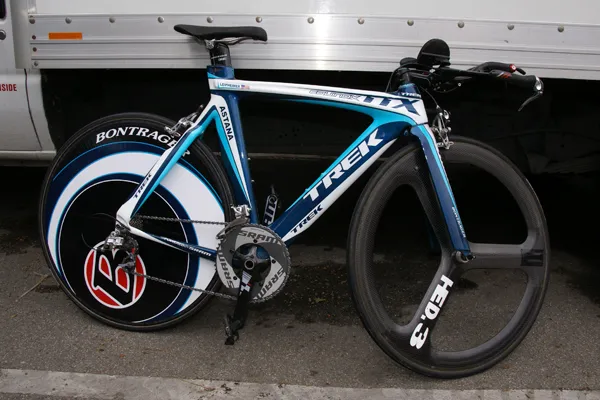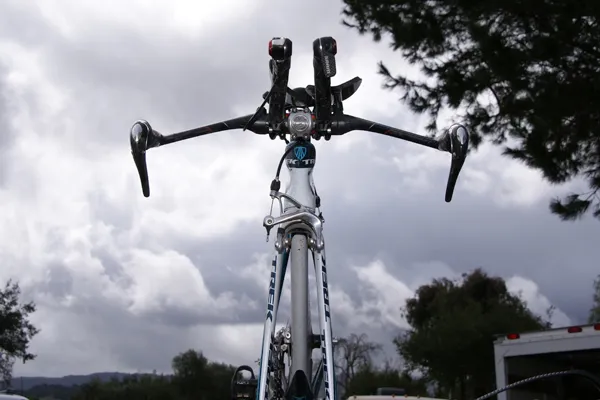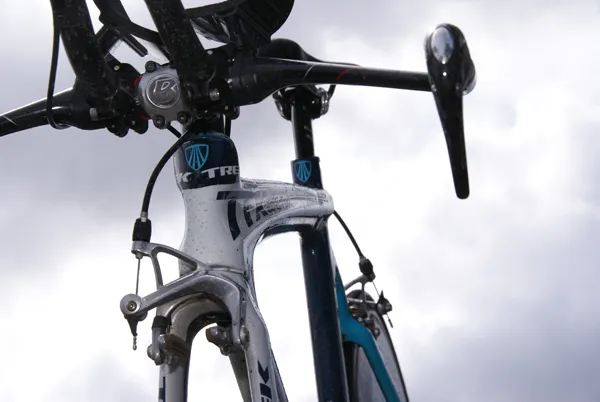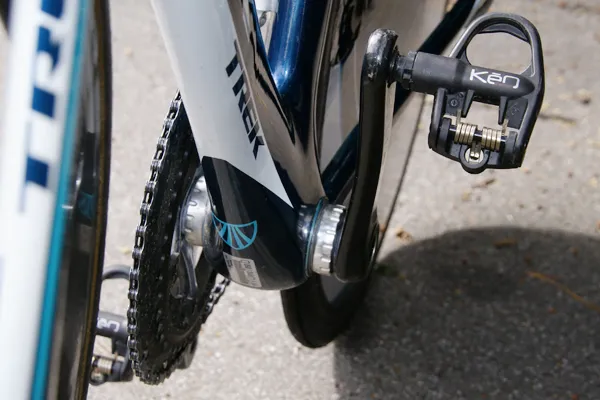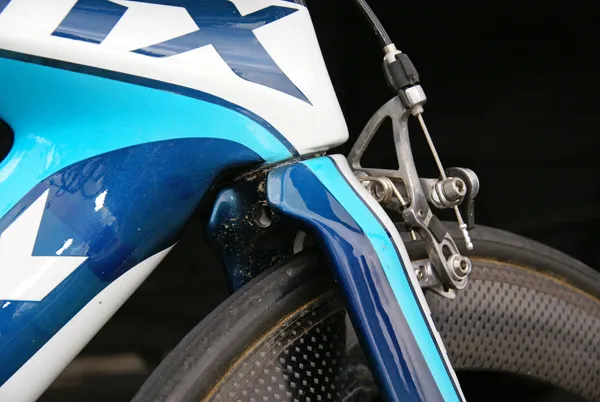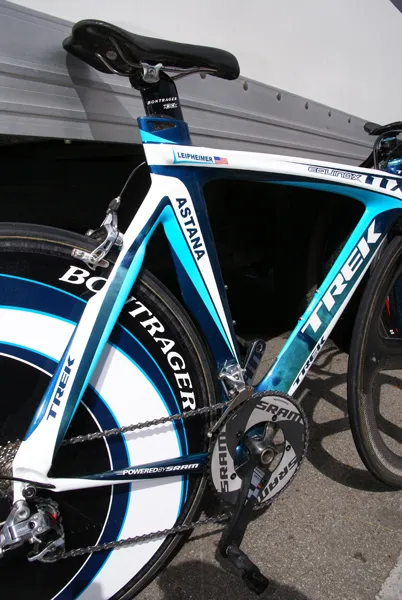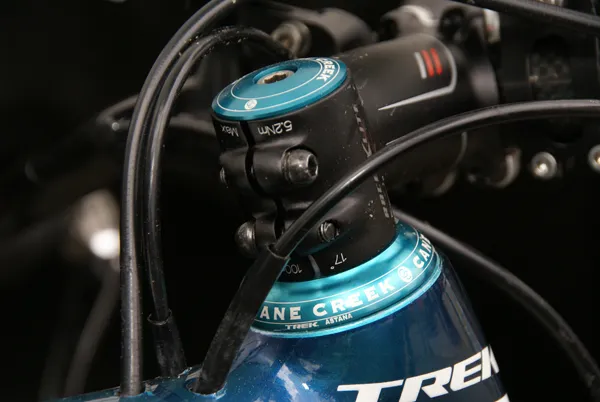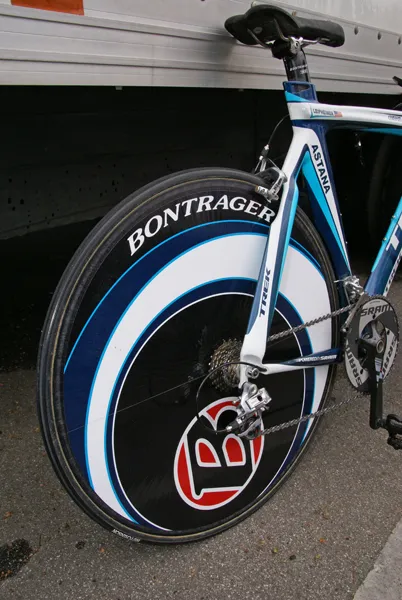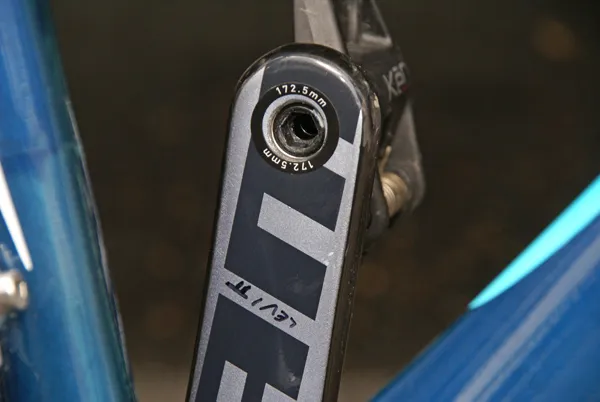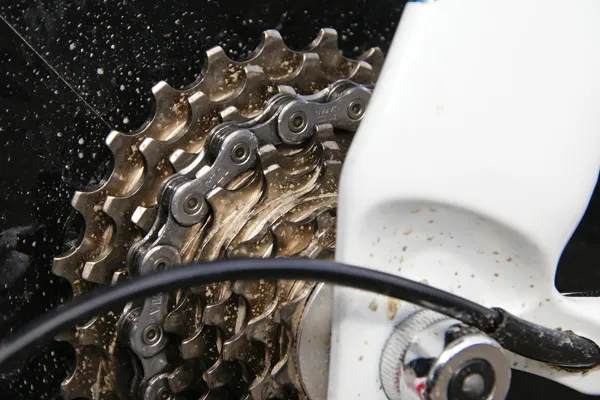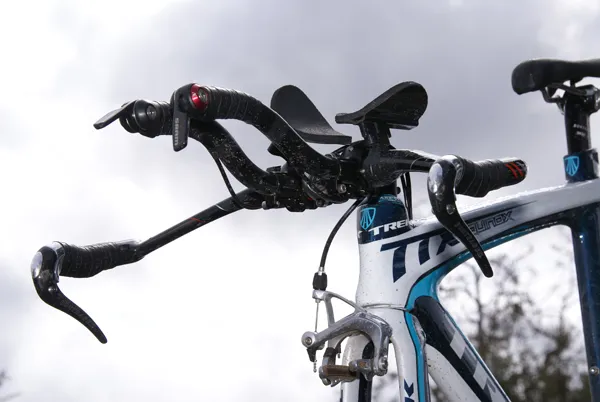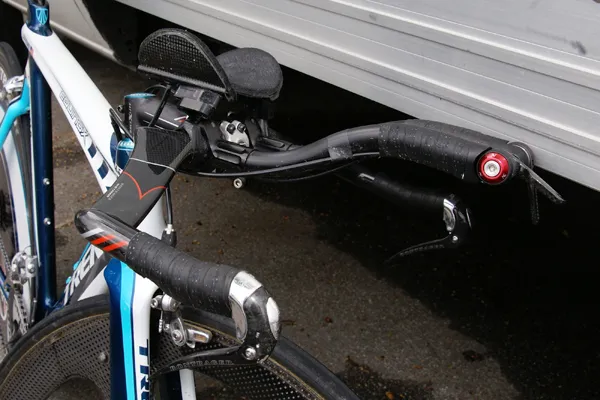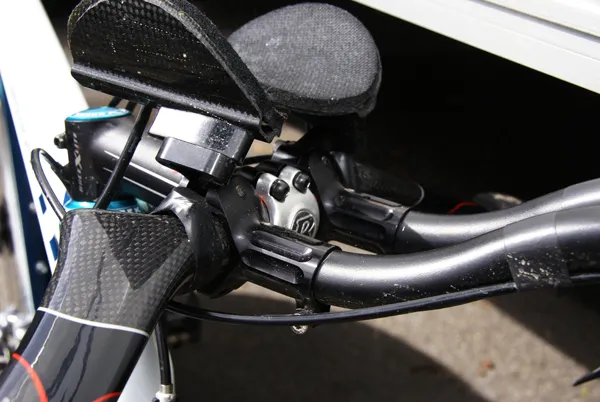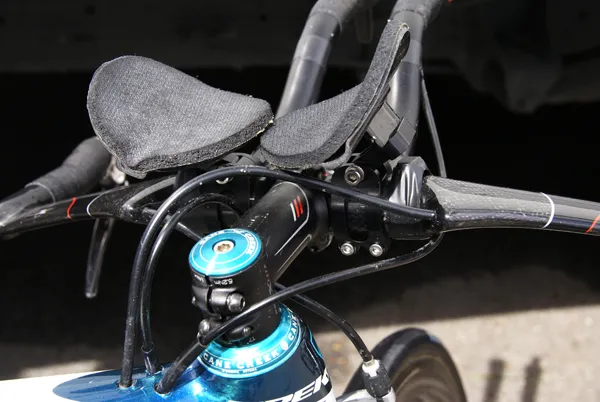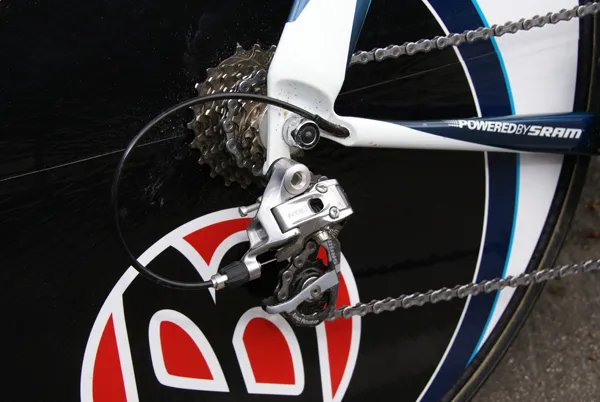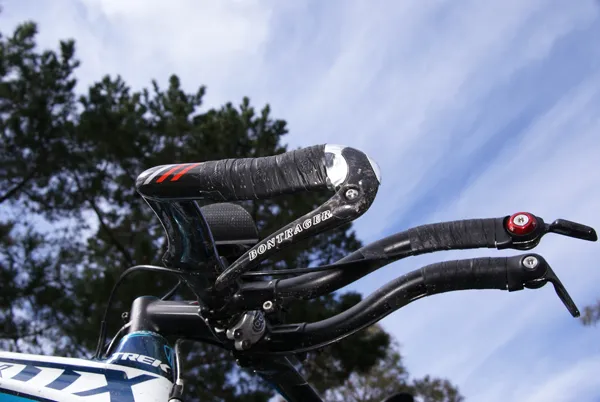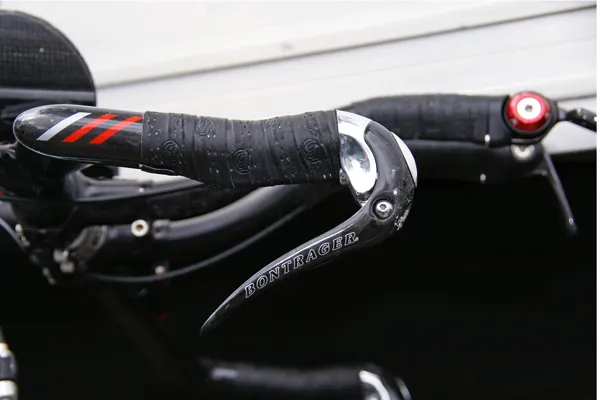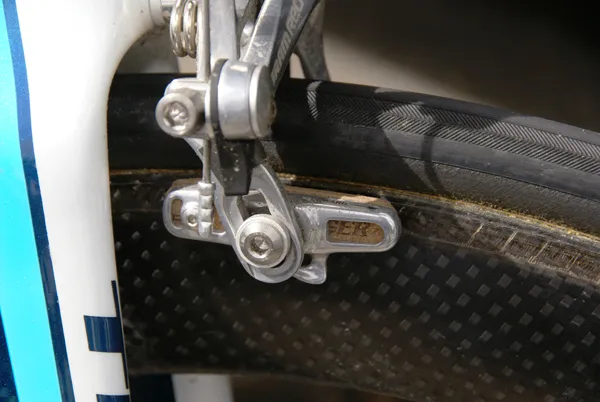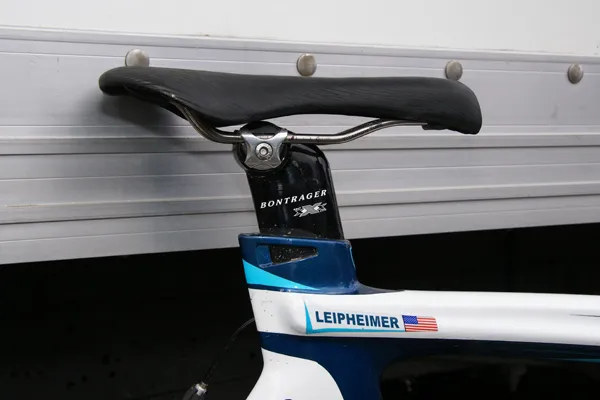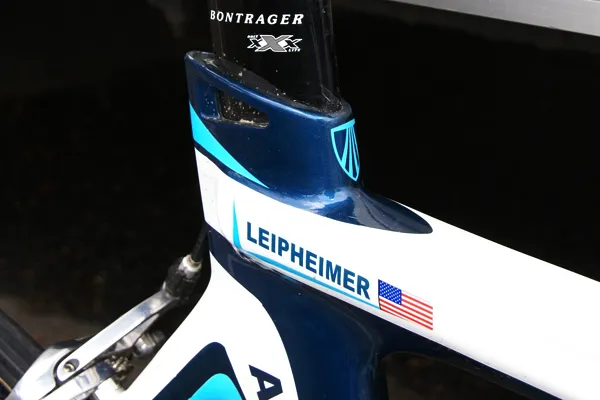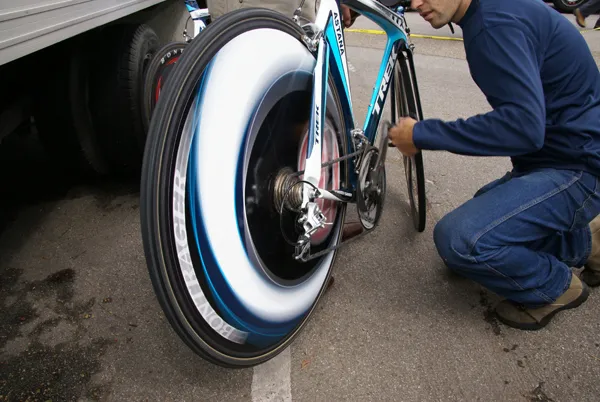Astana captain Levi Leipheimer secured the lead at this year’s Tour of California after posting the fastest time in the stage 5 time trial around Solvang, and went on to win the race overall. Team sponsor Trek equipped Leipheimer with a newly upgraded time trial machine.
Slippery shape
Trek says Leipheimer’s new Equinox TTX 9.9 SSL is not only the most aerodynamic frame it has ever crafted but also one that is measurably faster than some key competitors. The usual features are there, such as the deep section down tube, seat tube, seat stays and fork, but other smaller details set Astana’s machines apart from the field.
Nearly every aspect of the Equinox shape has been designed to ease the transition of passing air from frame section to frame section. According to Trek, the widely-set fork blades allow air to pass through more easily than the more typical narrowly-spaced prongs, saving 0.1lb of drag in the process. From there, the elongated fork crown offers a nearly seamless jump to the dropped down tube which is set closely enough to the front wheel to form a fairly continuous surface between the two. Naturally, the seat tube is fitted with a deep cutout to shield the rear wheel.
Most importantly, though, all of Trek’s aero talk isn’t just for semantics. Trek claims that Leipheimer posted the lowest drag numbers ever recorded by a male athlete on his new machine during a pre-season wind tunnel session in San Diego. That efficient position certainly aided him on the Solvang time trial course.
Light and stiff, too
In addition to being aero, Leipheimer’s Equinox TTX 9.9 SSL is also stiff and light, Trek says. The markedly wide top tube bears an unusual I-beam-like profile from the very front of the head tube nearly all the way to the seat tube. This not only maintains better airflow along its length but Trek says the shape is 50 percent stiffer than the previous TTX.
Leipheimer’s SSL version also benefits from Trek’s Red Series carbon fiber content and lay-up schedule which knocks 300g off of last year’s frame.
Some weight savings also come courtesy of a new build kit for 2008. Leipheimer’s rear wheel isn’t actually a Bontrager product in spite of the decal camouflaging; rather, it’s a Lightweight model from German outfit CarbonSports.
According to Trek team liaison Ben Coates, the company gave team director Johan Bruyneel the freedom to choose which disc wheels Astana used in competition as Bontrager wasn’t able to produce enough of its own Aeolus TT discs for all of the riders. As it is, the Lightweight’s sub-900g weight offers a 200g advantage over the Aeolus anyway and its stiff feel made for a worthy substitute. An expensive one, though: the team has to pay for them.
However, Coates says that the giant Bontrager decals aren’t just for sponsorship purposes. Team testing apparently has shown that the Lightweight’s somewhat porous surface isn’t quite as fast as a non-porous one so the decals (made by Victory Circle Graphix in Colorado) made the wheels faster, too.
Bontrager does supply Leipheimer’s Race X Lite Carbon base bar, though, which is fitted with a pair of Race XXX Lite Carbon Aero brake levers and a set of exceptionally narrowly-spaced HED clip-on aero bars. Out back, Leipheimer perches himself atop a custom-covered Selle Italia SLR T1 saddle.
Going Red
Astana has also swapped from Shimano Dura-Ace to SRAM Red this year which drops another 150g or so from 2007, at least on paper. Leipheimer’s bike at Tour of California was fitted with a prototype SRAM TT big ring that is still in development but reportedly substantially heavier than target figures so it’s hard to say how much of an advantage it really offered that day.
Either way, the new carbon fiber TT shifters are definite lighter than Dura-Ace. They’re adjustable to a unique degree too, so they can be better customised to the rider.
The PowerDome cassette only drops about 15g relative to Dura-Ace, but its novel construction should make it quite a bit more rigid and the all-steel cogs should wear better, too.
Specification
- Frame: Trek Equinox TTX 9.9 SSL, size small
- Fork: Bontrager Race XXX Lite TT
- Headset: Cane Creek integrated Astana team custom
- Stem: Bontrager Race X Lite, 100mm x -17°
- Handlebars: Bontrager Race X Lite Carbon Bullhorn, 42cm (c-c); HED clip-on aero bar
- Tape/grips: Bontrager Race Lite Grippy tape
- Front brake: SRAM Red
- Rear brake: SRAM Red
- Brake levers: Bontrager Race XXX Lite Carbon Aero
- Front derailleur: SRAM Red
- Rear derailleur: SRAM Red
- Shift levers: SRAM TT
- Cassette: SRAM OG-1090, 11-23T
- Chain: Shimano Dura-Ace CN-7801
- Crankset: SRAM Red, 172.5mm, 39/54T with prototype SRAM TT outer ring
- Bottom bracket: SRAM Red
- Pedals: Look KeO
- Front wheel: HED 3 Carbon with bearing seals removed
- Rear wheel: Lightweight Disc DT
- Front tire: Hutchinson tubular
- Rear tire: Hutchinson tubular
- Saddle: Selle Italia SLR T1
- Seat post: Bontrager Race XXX Lite TTX Carbon
Critical dimensions
- Rider's height: 1.7m (5' 7")
- Rider's weight: 60kg (132lb)
- Seat tube length, c-c: 500mm
- Seat tube length, c-t: 540mm
- Saddle height, from BB (c-t): 685mm
- Tip of saddle nose to C of bars (next to stem): 498mm
- C of front wheel to top of bars (next to stem): 505mm
- Top tube length: 520mm (horizontal)
- Total bicycle weight: 8.0kg (17.6lb)
